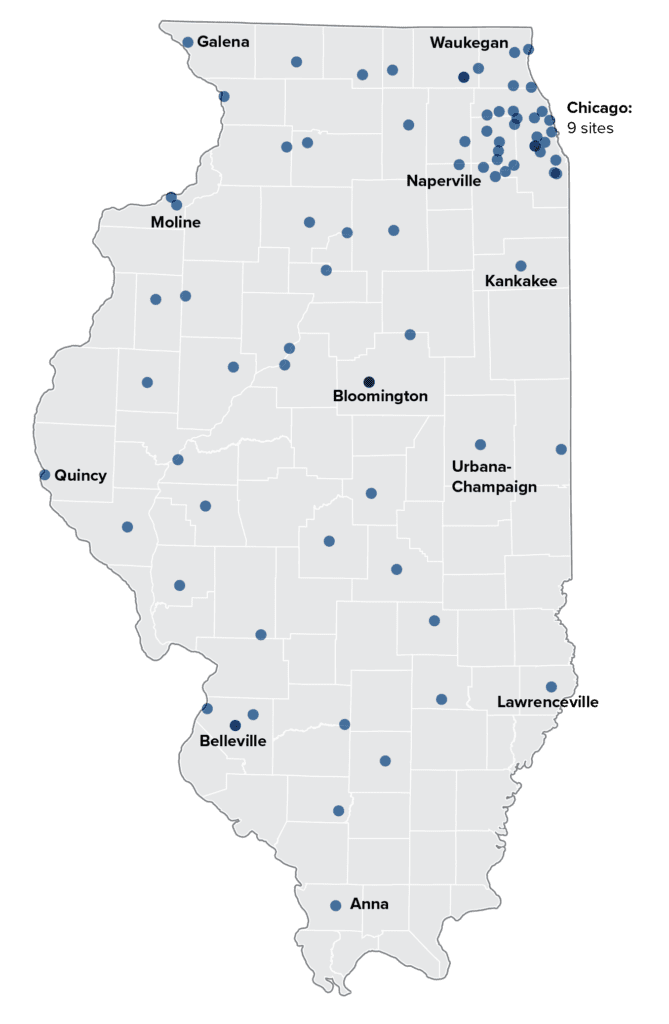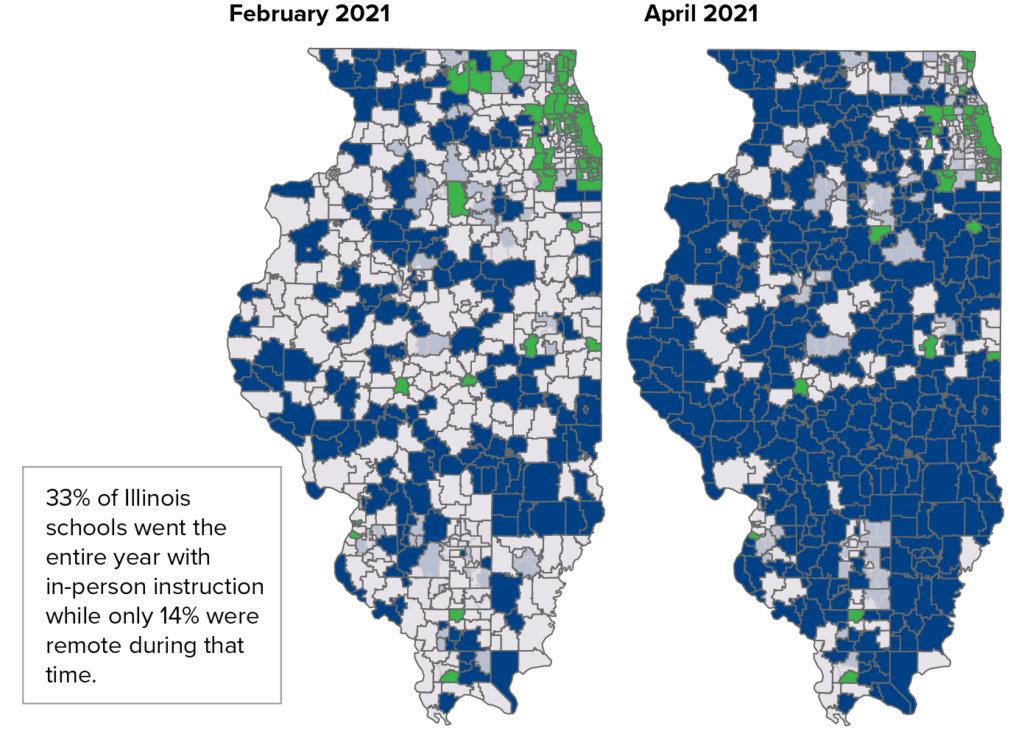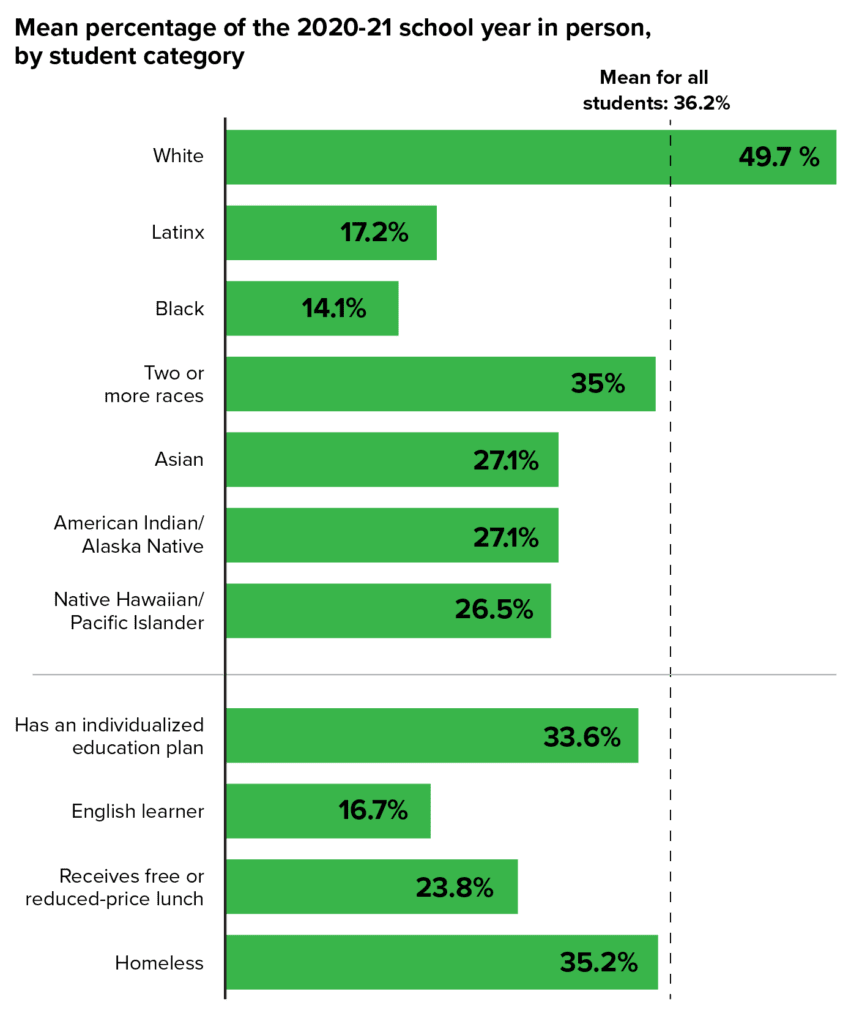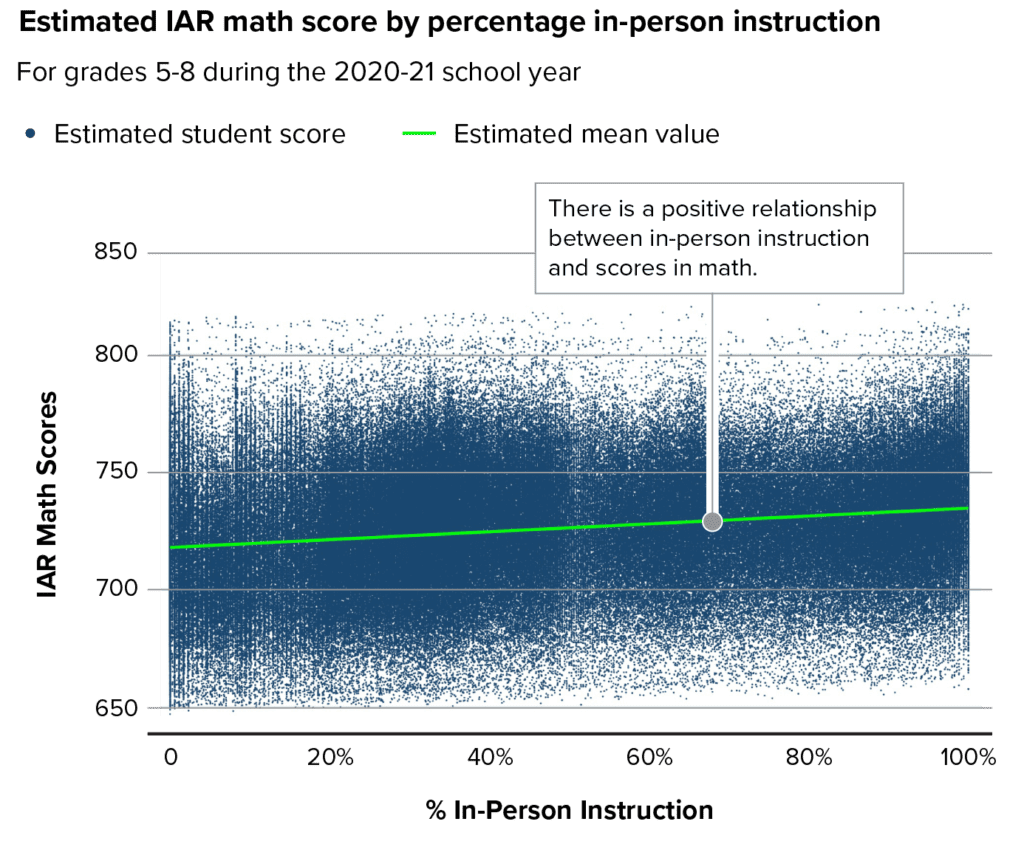We created this really diverse team with lots of expertise that has strengthened our ability to do the science, but also to make our science actionable.
— Rachel Poretsky, a microbial biologist at UIC and one of the leaders of the DPI wastewater science team.
> COVID-19 Wastewater Surveillance
Never a wasted opportunity
Through thousands of lab tests, DPI’s waste- water team has proven it can detect levels and variants of the coronavirus from sam- ples of raw sewage, a reliable alternative to individual test results in tracking COVID-19.
This enables the team to alert public health agencies to outbreaks throughout Illinois.
The team has succeeded by drawing from the complementary expertise of scientists from DPI, UIC, Argonne National Laboratory, and Northwestern University. The team possesses the can-do drive of a startup founder, the problem-solving insights of an innovator, and, when nothing else works, the DIY ingenuity of MacGyver.
Today, the DPI team is collecting raw sewage to test for the virus that causes COVID-19 at 75 sites across the state for the Illinois Department of Public Health and more than 16 sites in Chicago for the Chica- go Department of Public Health.
The samples are then couriered to a micro- biology lab at UIC for analysis, and a subset is taken to Argonne National Laboratory for gene-sequencing to identify virus variants.
Altogether, this makes this effort one of the largest wastewater surveillance systems in the nation.
How DPI MacGyvered a better way to test sewage
When researchers began collecting samples from sewer manholes, they followed com- mon practice, deploying automated sam- plers to siphon up liquid. Autosamplers are relatively expensive, plus their batteries die and their pumps freeze up in cold-weather locales like Chicago.
The solution the team came up with was to suspend a tampon in the sewer for at least 24 hours, but when testing this approach, the team found that the tampon would often be lost due to high flows and debris. So the team decided to try suspending the tampon within a mesh basket.
Charlie Catlett, DPI’s senior research scientist, rigged up a prototype in his suburban Chicago garage, using stainless steel parts from a hardware store. Rachel Poretsky, a microbial ecologist at UIC and the lead scientist on the team, then experimented in her lab with how best to extract enough liquid from the tampon to detect COVID-19 variants.
(It’s not as easy as you might think since tampons are designed not to leak.) Among the kitchen gadgets she tested were citrus squeezers, pomegranate juicers, and potato ricers.
The team has deployed 20 of its new con- contraptions in Chicago for further field-testing and modifications.
The savings are potentially enormous. An autosampler costs $5,000 to $12,000, and it takes 30 to 40 minutes to retrieve each sample. The parts of the tampon-in-a-basket cost about $100, and a retrieval can be done in half the time.
This means agencies could collect more data without spending more money, whether they’re watching for new strains of COVID-19 or some future pathogen that threatens lives.
Inventive and impactful — exactly how all DPI collaborations should be.

“DPI’s project, which was one of eight we funded in the very early days of the pandemic, demonstrated how wastewater surveillance can provide a snapshot of the health of communities at a point in time, giving public health workers valuable time to mobilize and respond to protect our communities.”
Total Funding: $17 million
Funding Sources:
- Discovery Partners Institute
- Illinois Department of Public Health
- Chicago Department of Public Health
- Walder Foundation
> IWERC: Illinois Workforce and Education Research Collaborative
Learning During the Pandemic
In June, IWERC announced the results of its Learning During the Pandemic series, which analyzed how remote and in-person learn- ing during COVID-19 affected students’ test scores. Lauryn Scott, DPI’s assistant director of marketing and communications, asked Meg Bates, IWERC’s director, to explain the findings.
Q. What impact did online learning have on students?
The pandemic was hard on learning. Test scores declined across the board, no matter whether students were entirely re- mote, in class, or in a hybrid environment.
But remote learning was especially hard for younger children. The benefits of be- ing in person were most pronounced for grades 3-5 (all subjects) and for grades 6-8 (math). It was especially beneficial for math scores.
We saw no difference at grade 11, so we think being in-person vs. remote didn’t matter as much as kids got older.
Q. Based on your findings, in-person learning worked best for younger children. Was there a specific group that received more in-person learning than others?
The unfortunate truth is that students who experienced more in-person instruction were disproportionately white and attended more affluent schools. Those who experienced remote instruction were disproportionately Black, Latinx, English learners, and low-income students.
Q. How can school districts within Illinois provide an equitable opportunity for students most impacted?
In grades 3-8, ethnic/racial and socioeconomic achievement disparities likely widened. Schools serving younger students and historically marginalized populations should try to provide additional support to address these learning losses, especially in math.
A transition from remote to in person
During the 2020-2021 school year, districts across Illinois transitioned from mostly remote learning to mostly in-person.


In-person learning varied by race, socioeconomic factors ...
White students had a higher rate of in-person learning than the state average while students of color had a lower rate of in-person learning during the 2020-21 school year.

... while those who did learn in person scored higher in tests.
Math test scores trended higher for students who had higher rates of in-person learning.

“The pandemic was hard on learning. Test scores declined across the board. But remote learning was especially hard for younger children.”
-Meg Bates
> I-BRAIN
Compiling Data on Brain Disorders and Using It to Discover Cures
Brain disorders and disease afflict 1 in 6 people, with epilepsy alone affecting an estimated 3.4 million Americans. Treatments are improving for many of these illnesses, but health data is often siloed. That hinders the ability of artificial intelligence to sort through it all to perceive patterns that could lead to bigger breakthroughs.
The Illinois Brain Analytics Institute, or I-BRAIN, is working toward a fix by collecting these data sets in one accessible repository. The team, led by Dr. Joseph Loeb, head
of neurology and rehabilitation at UIC’s College of Medicine, itself is an assemblage, bringing together researchers from UIC, UIUC, Illinois Tech, and private industry.
The team’s first big data effort is enhancing the immense library of information, including 3D imaging and genomics, linked to a unique collection of human epilepsy brain tissue housed at the University of Illinois NeuroRepository. This platform is designed to be expanded to integrate data on other brain disorders.
The team already has spin-out companies: one is developing software for exploring brain imaging, HER2 breast cancer, and genomic data; the second is developing markers and treatments for epilepsy and traumatic brain injuries.
“As a practicing neurologist, I often have to inform my patients they have a diagnosis without a cure, including epilepsy, ALS, and Alzheimer’s disease. We desperately need new ways to understand human brain disorders and, of course, treatments that actually cure them. I am thrilled to be leading I-BRAIN as a new way forward.”
— Dr. Jeffrey A. Loeb, head of neurology and rehabilitation at the UIC’s College of Medicine, and director of I-BRAIN.

> Making Drones That Detect Potential Faults in Bridges
What if you could pilot a drone not only to get 360-degree high-definition video of a bridge but also to detect what’s going on under the surface to assess its condition? We may be there soon.
The United States has more than 600,000 bridges, and many of them are in need of repair or even replacement. To avoid catastrophe, crews must be dispatched to inspect them all. Their toolkits today often include devices like ground-penetrating radar and infrared sensors that allow them to better assess each span’s structural integrity. Even so, the job is time-consuming and can be dangerous.
A DPI team is investigating how to outfit drones with multiple sensors to do these tasks more efficiently, accurately, and, because of their lower cost, perhaps more frequently. The team also envisions collecting the readings in a database that could be analyzed by computers trained to spot flaws before they become serious.
The international team, seeded with $125,000 by DPI, is led by Danilo Erricolo, an expert in electromagnetism and a professor in the College of Engineering at UIC. He is joined by engineering scholars with expertise in bridge investigation and sensor fusion from UIC, the University of Toronto, Tel Aviv University, and the National Research Council of Italy, and startup Droneasure.
“We would like to make bridge inspections faster, safer, more efficient, and more economical.”
— Danilo Erricolo, UIC professor of electrical and computer engineering, and team lead.
> Supporting R&D
Eight grants or contracts.
More on the way in these key sectors.

Agriculture

Health and Wellness

Transportation and Infrastructure

Information Technology

Water and Climate

More R&D partnerships with industry players are underway
12 teams,
$1.5M in awards
DPI's research partners
Argonne National Laboratory
Cardiff University
Chicago Department of Public Health Droneasure
Goshen Education Consulting
Illinois Association of Regional Superintendents of Schools
Illinois Department of Public Health
Illinois State Board of Education
Illinois State University Center for the Study of Education Policy
Illinois State Water Survey
Illinois Tech
Institute of Government and Public Affairs (Part of the U of I System) Kocree
Latino Policy Forum
Loyola University Chicago
Mayo Clinic
National Center for Supercomputing Applications
National Research Council of Italy
National Taiwan University
Northwestern University
Office of Governor J. B. Pritzker
Rush University
Tel Aviv University
Toyota Technological Institute of Chicago
University of Chicago
University of Illinois Chicago
University of Illinois Springfield
University of Illinois Urbana-Champaign
University of Pittsburgh
University of Toronto
Walder Foundation
Washington University

